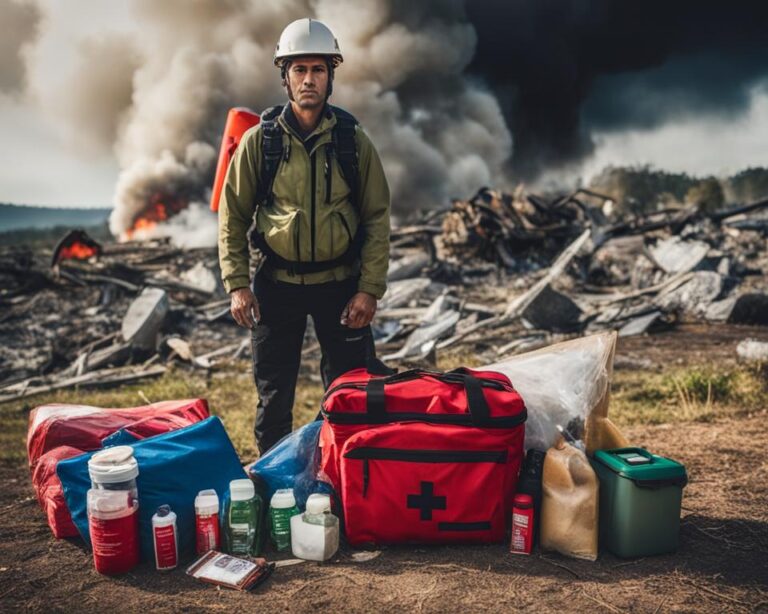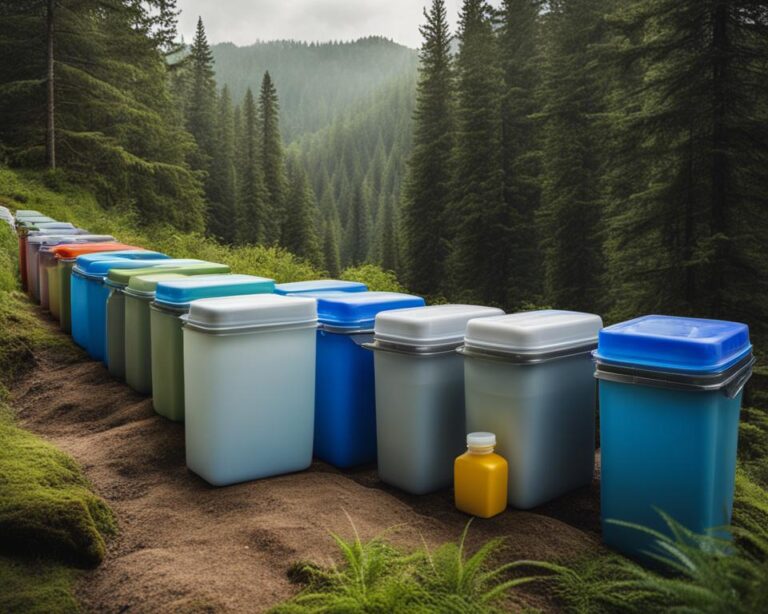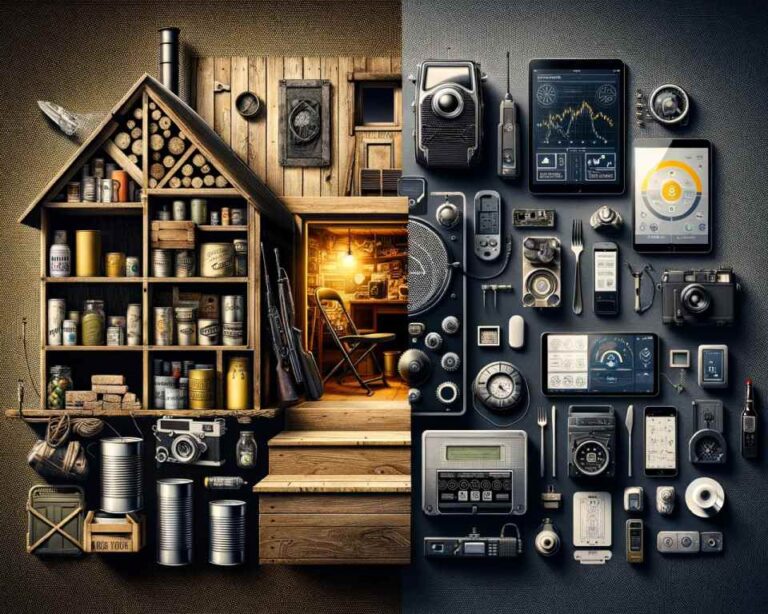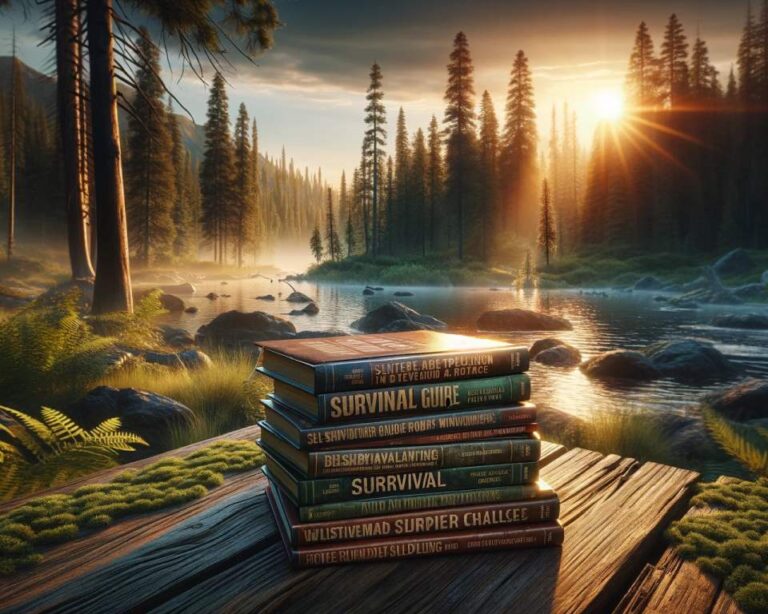Communication Strategies for Preppers in Wilderness Scenarios
Preparing for effective communication in wilderness scenarios is crucial for ensuring safety and connectivity during outdoor adventures. In a post-crisis situation, it is important to have alternative communication methods that do not rely on traditional phone networks.
In this article, we will explore various strategies and tools for wilderness communication, including satellite phones, two-way radios, ham radios, CB radios, flares, smoke signals, mirrors, chalk, and more. These communication tactics are essential for anyone venturing into the wilderness, ensuring effective communication and increasing the chances of a successful outdoor adventure.
Whether you are an avid hiker, camper, or prepper, having effective communication skills and tools is crucial in the wilderness. Let’s dive into the different communication strategies and techniques that can help you stay connected and safe in remote environments.
Satellite Phones: Reliable Communication in the Wilderness
When it comes to wilderness communication, having a reliable and effective means of staying connected is paramount. While traditional phone networks may not be accessible in remote areas or during emergencies, satellite phones, also known as Sat phones, offer a viable solution. As the name suggests, satellite phones utilize satellites to establish phone connections, making them independent of terrestrial infrastructure.
Satellite phones are particularly valuable in situations where the breakdown of society or being stranded in the wilderness makes communication with loved ones essential. Unlike regular cell phones, satellite phones are not dependent on the availability of cell towers or Wi-Fi networks. This means that even in the most remote locations, you can maintain communication and access emergency services if needed.
Investing in Reliable Communication
While satellite phones may come with a higher price tag and the need for a service plan, they are a worthwhile investment for those who prioritize reliable communication in the wilderness. These devices provide peace of mind, allowing you to stay connected and informed even when traditional communication methods are unavailable.
Additionally, satellite phones offer a range of features, including voice calls, messaging, and even internet access in some cases. These capabilities ensure that you can not only communicate with loved ones but also access crucial information, weather updates, and emergency assistance when necessary.
Tips for Using Satellite Phones in the Wilderness
- Ensure your satellite phone is fully charged before heading into the wilderness.
- Carry spare batteries or a portable solar charger to keep your satellite phone powered.
- Stay informed about coverage areas and satellite availability to optimize communication.
- Establish an emergency communication plan with trusted contacts before embarking on your wilderness adventure.
- Practice using your satellite phone before an emergency situation arises to familiarize yourself with its features and functionality.

“Satellite phones provide a lifeline in the wilderness, offering a reliable means of communication when traditional networks fail. Investing in a satellite phone can be a game-changer, ensuring that you can stay connected and seek help when needed during outdoor pursuits.”
Two-Way Radios: Staying Connected with Range and Versatility
In the wilderness, staying connected with others is vital for safety and coordination during outdoor adventures. Two-way radios, also known as walkie-talkies, are reliable communication devices that operate on non-phone networks, making them perfect for wilderness emergency communication.
Two-way radios are compact, portable, and easy to carry, making them ideal for hikers, campers, and other outdoor enthusiasts. These devices offer a wide range of channels and operating range, allowing you to stay in touch with fellow adventurers even when you are miles apart.
The Benefits of Two-Way Radios
Using two-way radios in the wilderness has several advantages:
- Range: Two-way radios have a range of up to 50 miles, depending on the terrain and environmental conditions. This extensive range ensures that you can maintain communication with your group, even if you become separated.
- Versatility: Two-way radios are versatile communication tools that can be used in various outdoor scenarios. Whether you are hiking, camping, or engaging in other wilderness activities, these devices provide a reliable means of communication.
- Instant Communication: With a simple push of a button, you can transmit your message instantly. This real-time communication allows for quick coordination and sharing of important updates.
- Privacy: Many two-way radios offer privacy codes or channels that allow you to have secure conversations with your group. This ensures that your communication remains confidential and prevents interference from other radio users.
Communication Protocol and Codenames
In order to optimize communication efficiency and eliminate confusion, it is essential to establish a communication protocol and use codenames when operating two-way radios in the wilderness. This ensures that your messages are clear, concise, and easily understood.
Example communication protocol:
“This is Base Camp to Alpha Team, do you copy?”
“Alpha Team, this is Base Camp, we copy. Over.”
Using codenames for team members and specific locations can help cut through unnecessary chatter and streamline communication.

Ham Radios: Robust Tools for Disaster Situations
Ham radios, also known as amateur radios, are powerful communication tools that play a crucial role in disaster situations. These radios are widely used by the military, emergency response groups, and survival enthusiasts for their reliable and versatile communication capabilities. While obtaining a license may be required to operate a ham radio, it is well worth the effort to join a supportive community that can guide users and understand the robust survival use of these radios.
Ham radios offer several advantages in emergency communication. They have a significantly larger range compared to regular two-way radios, allowing for long-distance communication even in remote areas. In times of crisis, when traditional communication methods fail, ham radios can provide a lifeline to the outside world, helping to coordinate rescue efforts, gather information, and stay connected with loved ones.
“Ham radios are invaluable tools in disaster situations. Their extended range and ability to connect with other radio operators mean that emergency messages can be relayed quickly and efficiently, ensuring timely assistance and support when it’s needed most.”
Paired with scanners, ham radios also offer the benefit of staying updated on local information, such as weather conditions, emergency broadcasts, and other developments in the area. This real-time information helps users make informed decisions and take appropriate actions to ensure their safety and well-being.
Operating a ham radio requires a certain level of technical knowledge and understanding of radio protocols. However, the complexity of these radios is outweighed by their effectiveness and reliability in emergency situations. With practice and training, users can become proficient in operating ham radios and fully utilize their potential.
Ham Radios: A Community of Support
One of the unique aspects of ham radios is the supportive community that surrounds them. Amateur ham radio operators often form clubs, networks, and organizations that provide guidance, foster communication, and share valuable resources. These communities are a valuable asset for survival use, as they can provide help, advice, and assistance in times of need.
Ham radio enthusiasts are dedicated to the principles of emergency communication and are always ready to assist others in distress. They organize drills, training sessions, and even emergency response exercises to ensure the effective use of ham radios during critical situations. Through these networks, users can tap into a wealth of knowledge, experience, and camaraderie that can make a significant difference in survival scenarios.
Ham Radios: A Key Component of Wilderness Safety
When venturing into the wilderness, whether for recreation or survival purposes, carrying a ham radio is highly recommended. These radios provide a vital means of communication, allowing you to call for help, coordinate rescue efforts, and stay connected with other members of your group. In isolated areas with no phone reception, a ham radio can be a lifeline that bridges the communication gap.
Imagine being lost in the wilderness with no means of contacting the outside world. A ham radio can be the difference between life and death, enabling you to reach out for assistance, share your location, and receive vital information that can aid in your rescue.
CB Radios: A Reasonable Alternative for Disaster Communication
When it comes to wilderness communication during disasters, CB radios offer a practical and reliable solution. While their effective range may be limited to 1-10 miles depending on the terrain, CB radios can be an invaluable tool for staying connected with family members in close proximity. In situations where cell phones are rendered useless or mobility becomes challenging, CB radios provide a viable means of communication.
CB radios, also known as Citizens Band radios, are commonly used radios that operate on a specific range of frequencies. They are easy to use, affordable, and widely available. Unlike other communication methods that rely on infrastructure or networks, CB radios create a direct line of communication between users. This makes them particularly useful in scenarios where traditional phone systems have collapsed or are overwhelmed.
One of the advantages of CB radios is their simplicity. They do not require a license to operate, making them accessible to anyone. Additionally, CB radios are equipped with multiple channels, allowing users to find an open frequency for communication. This feature reduces the risk of interference from other users and ensures clear and uninterrupted conversations.

CB radios are especially valuable for short-range communication needs in the wilderness. Whether you’re camping, hiking, or involved in outdoor activities, having a CB radio at hand can provide peace of mind and a means of emergency communication. In case of an accident or when separated from your group, a CB radio allows you to quickly summon help or get immediate updates on the situation.
It’s important to note that the range of CB radios can be affected by various factors such as terrain, weather conditions, and obstacles. In open areas, the range can extend up to 10 miles, while in densely wooded or mountainous regions, the range may be limited to just a mile or two. However, even with this limitation, CB radios remain a viable communication option within close proximity.
In summary, CB radios are a reasonable and practical alternative for disaster communication in the wilderness. From their simplicity and affordability to their direct communication capabilities, CB radios can keep you connected and informed during challenging times. Consider including a CB radio in your wilderness communication toolkit to ensure you have a reliable means of staying in touch, even when other communication methods fail.
Visual Signaling: Flares and Smoke for Wilderness Communication
In scenarios where electrically dependent communication methods are not possible, visual signaling becomes essential. Flares and smoke are effective means of survival communication.
“Flares can be used to signal distress and attract the attention of people or rescue teams from miles away.”
Flares are handheld pyrotechnic devices that emit a bright light, typically red or orange, and are used to signal an emergency or distress. They are highly visible and can be seen from far distances, making them an excellent tool for wilderness emergency communication. Flares can be ignited and launched into the air, creating a visible and attention-grabbing signal to notify others of your location.
“Smoke signals, created by different types of smoke, can convey messages and communicate important information.”
Smoke signals are another method of visual communication used in wilderness scenarios. By creating smoke using various materials such as damp leaves, wet wood, or other natural resources, signals can be conveyed and messages can be communicated over longer distances. Different patterns or durations of smoke can communicate specific messages or indicate the presence of danger or emergency. It is essential to have an understanding of the different types of smoke signals and their meanings in order to effectively use this method of wilderness communication.
Both flares and smoke signals have been utilized by various cultures and tribes throughout history, proving their effectiveness in wilderness emergency situations. By incorporating these visual signaling techniques into your emergency preparedness plan, you can increase your chances of being located and rescued in the event of an outdoor emergency.
Using Mirrors and Chalk for Survival Communication
In wilderness scenarios where traditional communication methods may not be available, it’s essential to rely on alternative strategies to ensure your message reaches others. Two effective survival communication tools that can come in handy in such situations are mirrors and chalk.
Reflecting Sunlight with Mirrors
Mirrors can be compact, lightweight, and inexpensive, making them a practical choice for survival communication. By angling a mirror correctly, you can reflect sunlight and catch the attention of others. This technique can be especially useful during the day or in open areas where your signal has the potential to travel a significant distance.
To use a mirror for wilderness communication, hold it at an angle that reflects the sun’s rays towards your intended recipient. You can create short bursts or long, sweeping motions with the reflected light to increase visibility. Keep in mind that clear weather conditions and direct sunlight optimize the effectiveness of this method.
Creating Distress Signals with Chalk
Chalk can be a simple yet powerful tool when it comes to survival communication. It allows you to create large, visible distress signals that can be easily viewed from high above or far away. Whether you’re marking a trail for search and rescue teams or leaving coded messages for fellow adventurers, chalk can serve as a versatile communication tool.
Choose a vibrant-colored chalk to maximize visibility. Utilize large, bold lettering or symbols to increase the chances of your message being understood. Remember, simplicity and clarity are key when using chalk for wilderness communication.

These analog methods of communication can be invaluable when other forms of communication are not available. Whether you’re stranded, lost, or seeking rescue in the wilderness, mirrors and chalk offer a practical means of signaling for help or relaying vital information to others.
By incorporating mirrors and chalk into your remote communication strategies, you can enhance your chances of being noticed, understood, and ultimately rescued in survival situations.
Cordage: Essential for Securing and Signaling
When it comes to wilderness communication, cordage is an essential tool for outdoor enthusiasts. The knowledge of tying knots and utilizing ropes can make a significant difference in ensuring security, survival, and effective signaling in the wilderness.
Properly tying knots allows you to secure shelters, keeping them sturdy and protected even in inclement weather conditions. Whether it’s setting up a tent, creating a makeshift hammock, or constructing a lean-to shelter, cordage plays a vital role in maintaining stability and providing a safe haven.
Cordage is also crucial for securing tarps, which can protect you from rain, wind, and sun exposure. By firmly anchoring tarps with knots, you can create a reliable shield against the elements, ensuring your comfort and well-being during your outdoor adventures.
Moreover, cordage provides the flexibility to improvise and adapt in the wilderness. Whether it’s creating impromptu fishing lines, repairing gear, or fashioning tools, having cordage readily available allows for endless possibilities and resourcefulness.
But cordage is not just useful for securing and improvising—it is also a valuable tool for signaling in emergency situations. By strategically tying brightly colored ropes or attaching reflective objects, you can create eye-catching signals that help rescuers locate and identify your position.
“Cordage is like an invisible thread that connects us to safety and resourcefulness in the wilderness.”
Remember, when it comes to cordage, quality matters. Invest in durable, lightweight ropes that can withstand the demands of the wilderness. Learn various knots such as the clove hitch, square knot, and bowline, as they are fundamental for effective cordage usage.
By mastering the art of cordage and harnessing its power, you equip yourself with an essential communication tool that ensures security, survival, and adaptability in the great outdoors.
Basic Medical and Navigation Skills for Wilderness Communication
In order to ensure effective wilderness communication, it is essential to have basic medical skills and navigation techniques. These skills not only contribute to your safety but also play a crucial role in maintaining communication during outdoor adventures.
First and foremost, having knowledge of basic medical skills is vital for handling medical emergencies in the wilderness. Being equipped with first aid knowledge, including CPR, wound treatment, and trauma care, can be lifesaving when professional medical assistance is not readily available. Understanding how to assess injuries, administer basic treatments, and stabilize a patient’s condition will greatly improve your chances of survival while awaiting rescue.
Furthermore, navigation techniques are equally important for effective wilderness communication. Being skilled in using maps, compasses, and GPS units allows you to determine your location accurately, plan routes, and avoid getting lost. When venturing into unfamiliar territory, having the ability to read topographic maps, plot coordinates, and interpret landmarks can guide you towards designated meeting points or rescue locations, enabling you to communicate your whereabouts more efficiently.

By developing both basic medical and navigation skills, you enhance your outdoor survival communication skills and increase your self-reliance in challenging situations. These skills empower you to make informed decisions, provide essential medical assistance, and navigate through the wilderness with confidence. Remember, in the wild, effective communication is not just about devices and tools; it’s about having the knowledge and skills to adapt to unexpected situations and ensure your own safety.
FAQ
What is a satellite phone and why is it useful in the wilderness?
A satellite phone, also known as a Sat phone, is a reliable communication tool in the wilderness as it does not rely on traditional phone networks. It uses satellites to bounce signals and establish phone connections. Satellite phones are useful in the wilderness because they can maintain communication even when traditional phone networks are unavailable.
How do two-way radios help in staying connected in the wilderness?
Two-way radios, also known as walkie-talkies, are versatile communication devices that operate on non-phone networks. They are compact, easy to carry, and have a wide range of channels and operating range. With a two-way radio, you can stay in touch with people up to 50 miles away or even longer depending on the terrain. They are effective tools for wilderness communication.
What are ham radios and how are they useful in disaster situations?
Ham radios are powerful communication tools often used by the military and emergency response groups in disaster situations. They require a license but provide a supportive community that can help guide users in their robust survival use. Ham radios can also be paired with scanners to stay updated on local information. They offer a more complex operation compared to two-way radios but are highly effective communication tools in the wilderness.
How can CB radios be used for communication during disasters?
CB radios are commonly used radios and can serve as a reasonable alternative for communication during disasters. While their effective range may be limited to 1-10 miles depending on the terrain, they can be useful for communicating with family members in close proximity. In situations where cell phones are not functional and mobility is difficult, CB radios can be valuable communication tools to consider.
How do flares and smoke signals aid in survival communication?
Flares can be used to signal distress and attract the attention of people or rescue teams from miles away. Smoke signals, created by different types of smoke, can convey messages and communicate important information. Both flares and smoke signals have been used by various cultures and tribes throughout history as effective means of survival communication.
How can mirrors and chalk be used for survival communication in the wilderness?
Mirrors, when angled correctly, can reflect sunlight and catch the attention of others. They can be compact, lightweight, inexpensive, and work as long as there is sunlight. Chalk can be used to write coded messages or create large distress signals that can be easily viewed from high above. These analog methods of communication can be invaluable when other forms of communication are not available in the wilderness.
What is cordage and why is it important for wilderness communication?
Cordage, or the knowledge of tying knots and utilizing ropes, is an important skill for wilderness communication. Properly tying knots can help secure shelters, keep tarps in place during inclement weather, and ensure overall safety and survival. Having cordage available allows for improvisation and flexibility when it comes to signaling or creating structures in the wilderness.
What basic skills should I have for wilderness communication?
In order to ensure effective wilderness communication, it is important to have basic medical and navigation skills. Being prepared for medical emergencies with knowledge of basic first aid, wound treatment, and trauma skills can be life-saving in the wilderness. Additionally, having navigation skills such as using maps, compasses, and GPS units can help prevent getting lost and aid in reaching designated meeting points or rescue locations. These skills are essential for self-rescue and maintaining communication during outdoor adventures.







